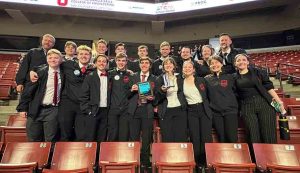Robotics
2024-25
2023-24
HURRICANE — Hurricane High School is part of the The First Innovation In Recognition of STEM Science and Technology and the home of team Black Ops, a group of 20 students that design, build, program, drive and market their robot.
But this team has a leg up on the competition. They recently visited Crunch Labs, the brainchild of 30-million-subscriber YouTube sensation Mark Rober, for three days.
“He’s like the modern day Bill Nye,” David Vick, the faculty member of the program, told St. George News.
Rober helped them with their learning process. The students said this gives them an advantage over competitors.

“The robot really didn’t look like anything at all, we kind of just had this base. he kind of helped us with our process,” said David Henderson, one of the captains of Black Ops.
What makes this robotics program unique is that success isn’t measured by championships or trophies.
“We measure success based on the skills that each one of our kids possess,” Vick said.
Each member is required to become familiar with every part of the process and be able to handle each software required to create the robot. Students also learn ho w to use AutoCAD, a design software, Python, a coding language, and Adobe Illustrator, an art software.
w to use AutoCAD, a design software, Python, a coding language, and Adobe Illustrator, an art software.
BlackOps participants are not enrolled in a club or after school program where anyone can sign up. Instead, these students are hand picked by academic merit. The program has grown its membership, but still doesn’t have as many students as other teams they have encountered.
In the past, the program competed in both the FIRST Technical Challenge and FIRST Robotics Competitions, while this year focusing primarily on FRC. While FTC involves smaller robots with an 18 by 18-inch cube, FRC features larger robots with a prototype size up to 30 by 30 inches.
Funding for the program, with an annual registration cost of $6,000, primarily comes from community contributions and fundraisers. The program has previously received grants, including one from the Department of Defense.
They’re in week two of their six-week allocated time to build their robot. They’re looking forward to improving on their prototype and to be ready for the competition in late February.
 “We don’t use kids to build robots; we use robots to build kids,” Vick said.
“We don’t use kids to build robots; we use robots to build kids,” Vick said.







